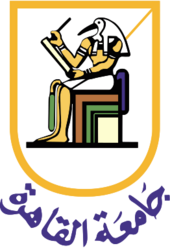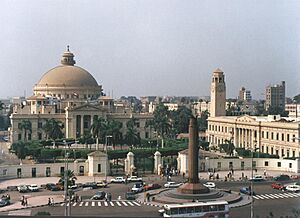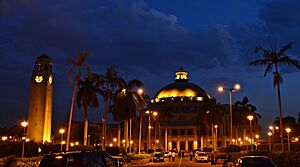Cairo University facts for kids
|
جامعة القاهرة
|
|
 |
|
| Latin: Universitas Cairensis | |
|
Former names
|
Egyptian University (1908–1940) Fuad I University (1940–1954) |
|---|---|
| Motto |
التميز في التعليم الجامعي
|
|
Motto in English
|
Excellence in Higher Education. |
| Type | Public |
| Established | 1908 |
| Founder | Fuad I (Most prominent) |
|
Academic affiliation
|
UNIMED AAU AUF |
| President | Mohamed Samy Abdel-Sadak |
|
Academic staff
|
14,518+ (2024) |
| Students | 207,853+ (2024) |
| Location |
,
,
Egypt
30°01′39″N 31°12′37″E / 30.02760°N 31.21014°E |
| Campus | Urban |
| International Students | 6,963+ (2024) |
| Mascot | Thoth |
| Website | (English version) |
 |
|
Cairo University (Arabic: جامعة القاهرة, romanized: Jāmiʿat al-Qāhira) is a very important public university in Egypt. Its main campus is in Giza, right across the Nile River from Cairo. It was started on December 21, 1908. At first, its different schools were in various places around Cairo. Then, in October 1929, they moved to the main campus in Giza.
The university has had a few names over the years. From 1908 to 1940, it was called the Egyptian University. Then, from 1940 to 1952, it was known as King Fuad I University. It is the second oldest university in Egypt, after Al-Azhar University.
Cairo University was first started and funded by a group of private citizens and supported by the royal family in 1908. It became a state-run university in 1925 under King Fuad I. After he passed away, it was renamed in his honor in 1940. It got its current name after the 1952 Egyptian revolution. Today, the university has about 155,000 students in 20 different schools (called faculties) and 3 other institutions. Many famous people have studied here, including three who won Nobel Prizes. It is one of the 50 largest universities in the world based on how many students it has.
Contents
History of Cairo University
Before 1907, the British representative in Egypt, Lord Cromer, didn't want a university to be built in Egypt. He worried it might cause problems. But the university opened anyway in 1908 as a small private school. Because it was one of the first of its kind in the Arab world, it became a model for other universities that were built later. In 1925, it became a state university, and in 1954, it was officially named Cairo University.
The university was founded because people wanted a national center for higher education. Some schools, like the College of Engineering (كلية الهندسة), existed even before the university was officially created. Cairo University was designed to be a modern, non-religious university, different from the religious Al Azhar. It became a leading example for other state universities in the country. In 1928, for the first time, female students were allowed to enroll at the university.
How Cairo University Started
Around the early 1900s, smart people in Egypt started asking for a new Egyptian university. They wanted to offer modern, professional education to Egyptians. One of the first people to suggest this was Yaqub Artin in 1894. He thought that existing professional schools could become the base for a university. These schools included ones for management, law, engineering, agriculture, and antiquities.
Many important Egyptians helped make the university happen. Rich landowners, government officials, members of the royal family, journalists, lawyers, and teachers all got involved. Princess Fatma Ismail gave land to the university and helped raise money. Other wealthy Egyptians also promised money. In 1906, a committee was formed to help create the university. Even though there were some disagreements at first, the project moved forward. By the time the university was officially established in 1908, Prince Fuad I was in charge.
Challenges in Starting the University
The British government in Egypt, especially Lord Cromer, was against starting a university for a long time. They worried that a European-style education might lead to political problems or strong national feelings among Egyptians. Education in Egypt was not a priority for the British government. Less than 1% of the state budget went to education.
In its early years, Cairo University didn't have one main campus. Lectures were held in different palaces and meeting halls. The university also faced money problems, especially during World War I. When it first opened in 1908, there was a section for women, but it closed in 1912. Women were allowed to study in the arts school again starting in 1928.
Another challenge was finding enough qualified teachers. There weren't many Egyptians with advanced degrees who could teach in Arabic and knew a lot about Western studies in their fields. So, many early teachers were European experts who spoke classical Arabic. The university also sent its own students abroad to get the training they needed to become professors.
In 1925, the university was officially re-established and grew bigger as a state institution under King Fuad I. The arts college joined with the law and medical schools, and a new science school was added. Ahmed Lutfi al-Sayyid became the first president of the university.
University Rankings
| University rankings | |
|---|---|
| Global – Overall | |
| ARWU World | 301–400 (2023) |
| CWUR World | 531 (2022-23) |
| CWTS World | 294 (2022) |
| QS World | =347 (2026) |
| THE World | 801–1000 (2024) |
| USNWR Global | =392 (2022) |
| National – Overall | |
| ARWU National | 1 (2021) |
| CWTS National | 1 (2022) |
| CWUR National | 1 (2022–2023) |
| QS National | 2 (2023) |
| USNWR National | 1 (2022) |
Cairo University is often considered one of the best universities in Egypt and one of the top universities in Africa.
- In the QS ranking for 2021, Cairo University was ranked 2nd in Egypt and 6th in Africa. Worldwide, it was ranked between 561st and 570th.
- In the ARWU 2020 ranking, the university was ranked 1st in Egypt and between 401st and 500th worldwide.
- According to the Center for World University Rankings (CWUR) for 2020–21, the university was ranked 1st in Egypt and 558th worldwide.
University Structure
Cairo University has many different schools, called "faculties," where students can study various subjects. These include a School of Law and a School of Medicine. The Medical School, also known as Kasr Alaini (القصر العيني), was one of the first medical schools in Africa and the Middle East. Its first building was given by Alaini Pasha.

When the Egyptian University was founded in 1908, most of the existing higher education institutions in Egypt (except Al-Azhar) became part of it. For example, Kasr Alainy (Medical School), Muhandess Khana (School of Engineering), and Dar Al-Uloom (House of Science) all joined. They became "Faculties" of the university. Over time, other new faculties were also created.
Here are some of the schools that became part of Cairo University:
| School | Started | |
|---|---|---|
| 1 | School of Engineering | 1816 |
| 2 | School of Medicine | 1827 |
| 3 | School of Pharmacy | 1829 |
| 4 | School of Veterinary Medicine | 1827 |
| 5 | School of Agriculture | 1823 |
| 6 | School of Law | 1868 |
| 7 | Dar Al-Uloom (House of Science) | 1872 |
| 8 | School of Commerce | 1837 |
Famous People Who Studied Here
Many important and famous people have studied at Cairo University. Here are just a few:
- Abdel Khalek Sarwat Pasha (1873–1928), who was the Prime Minister of Egypt twice.
- Mohamed Atalla, an engineer who invented important parts of modern electronics.
- Naima Ilyas al-Ayyubi, the first female lawyer in Egypt.
- Boutros Boutros-Ghali, who was the sixth Secretary-General of the United Nations.
- Eli Cohen, an Israeli spy.
- Taher Elgamal, who designed an important encryption system used for online security.
- Wael Ghonim, an Egyptian activist.
- Basma Hassan (born 1976), a famous actress.
- Saddam Hussein (1937–2006), a former president of Iraq.
- Yuriko Koike (born 1952), a former Japanese Minister of Defense and the first female governor of Tokyo.
- Adly Mansour, who was the temporary President of Egypt.
- Mohamed Morsi (1951–2019), a former President of Egypt.
- Amr Moussa, who was the Secretary-General of the Arab League.
- Omar Sharif (1932–2015), a famous actor who won three Golden Globe Awards.
- Magdi Yacoub (born 1935), a well-known heart surgeon.
- Walid Muallem, a Deputy Prime Minister and Minister of Foreign Affairs for Syria.
- Mostafa Madbouly, the current Prime Minister of Egypt.
Nobel Prize Winners
Cairo University is proud to have three graduates who have won the Nobel Prize, one of the most important awards in the world:
- Naguib Mahfouz, who won the Nobel Prize for Literature in 1988 for his amazing writing.
- Yasser Arafat, who won the Nobel Peace Prize in 1994 for his efforts towards peace.
- Mohamed ElBaradei, who won the Nobel Peace Prize in 2005 for his work to prevent the spread of nuclear weapons.
See also
- List of Islamic educational institutions
- Ahmed Lutfi el-Sayed, the first president of Cairo University
- Education in Egypt
- List of universities in Egypt






